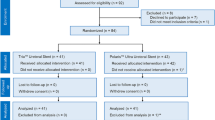Abstract
We review our experiences with forgotten stents and investigate the potential factors determining the degree of encrustation. Our series consists of nine cases of forgotten stent that had remained indwelling for more than 1 year (mean 36.1 months). We describe and compare their various clinical parameters in terms of encrustation. In addition, we briefly summarize our management schemes. All patients showed few stent related irritative symptoms. Six cases showing minimal or no encrustation shared the common feature of urine hypotonicity. Cystoscopic pullout was possible in these cases. The remaining three cases showed moderate to severe encrustation around the stent which required multiple procedures. Pyuria was observed in all cases and two patients had a history of urolithiasis. Finally, all cases were rendered stent and stone free. The fate of forgotten stents was dependent on the amount of encrustation around the stent. In our study, lithogenic history and presence of pyuria were associated with moderate to severe encrustation. Interestingly, patients showing urine hypotonicity tended to have a minimal encrustation on their stents and the stents were easily removed. Therefore, in patients with an impaired renal concentrating ability and a poor medical condition, the duration of indwelling stents might be safely prolonged if the patient has no risk factor for encrustation. As patients with forgotten stents are less likely to complain of stent related symptoms, thorough education of patients is important to prevent stent related complications.

Similar content being viewed by others
References
Zimskind PD, Fetter TR, Wilkerson JL (1967) Clinical use of long-term indwelling silicone rubber ureteral splints inserted cystoscopically. J Urol 97: 840
Franco G, De Dominicis C, Dal Forno S, Iori F, Laurenti C (1990) The incidence of post-operative urinary tract infection in patients with ureteric stents. Br J Urol 65: 10
Mohan-Pillai K, Keeley FXJr, Moussa SA, Smith G, Tolley DA (1999) Endourological management of severely encrusted ureteral stents. J Endourol 13: 377
Monga M, Klein E, Castaneda-Zuniga WR, Thomas R (1995) The forgotten indwelling ureteral stent: a urological dilemma. J Urol 153: 1817
Borboroglu PG, Kane CJ (2000) Current management of severely encrusted ureteral stents with a large associated stone burden. J Urol 164: 648
Singh I, Gupta NP, Hemal AK, Aron M, Seth A, Dogra PN (2001) Severely encrusted polyurethane ureteral stents: management and analysis of potential risk factors. Urology 58: 526
Somers WJ (1986) Management of forgotten or retained indwelling ureteral stents. Urology 47: 431
Reid G, Denstedt JD, Kang YS, Lam D, Nause C (1992) Microbial adhesion and biofilm formation on ureteral stents in vitro and in vivo. J Urol 148: 1592
Cormio L, Talja M, Koivusalo A, Makisalo H, Wolff H, Ruutu M (1995) Biocompatibility of various indwelling double-J stents. J Urol 153: 494
Keane PF, Bonner MC, Johnston SR, Zafar A, Gorman SP (1994) Characterization of biofilm and encrustation on ureteric stents in vivo. Br J Urol 73: 687
Kehinde EO, Al-Awadi KA, Tawheed A, Al-Hunayan A, Ali Y, Mahmoud AH (2001) Factors affecting the fate of prolonged forgotten ‘J’ stents. Scand J Urol Nephrol 35: 222
Persky L, Lockhart JJ, Karp R, Helal M, Hakki S (1990) The overlooked, retained double J stent. Urology 36: 519
Chitale SV, Scott-Barrett S, Ho ET, Burgess NA (2002) The management of ureteric obstruction secondary to malignant pelvic disease. Clin Radiol 57:1118
Auge BK, Preminger GM (2002) Ureteral stents and their use in endourology. Curr Opin Urol 12:217
Author information
Authors and Affiliations
Corresponding author
Rights and permissions
About this article
Cite this article
Park, K., Jeon, SS., Park, H. et al. Clinical features determining the fate of a long-term, indwelling, forgotten double J stents. Urol Res 32, 416–420 (2004). https://doi.org/10.1007/s00240-004-0442-6
Received:
Accepted:
Published:
Issue Date:
DOI: https://doi.org/10.1007/s00240-004-0442-6




